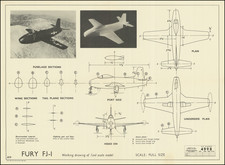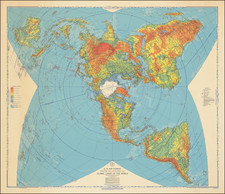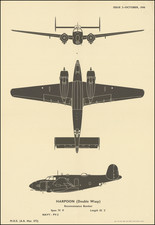P2V Neptune and PBM Mariner, an aircraft identification poster prepared by the Ministry of Supply and promulgated by the Admiralty, War Office, and Air Ministry in December 1950, presents an insightful documentation of these two fighter aircrafts. The poster, printed by G.C.M. Printing Service Ltd. for H.M. Stationery Office in Leicester, encapsulates the key features and the pioneering advancements of this significant American fighter jet.
In the immediate post-war period, the advancement of jet propulsion technology was ushering a transformative phase in global aviation. These two jets epitomized this era of innovation.
Technical innovation is showcased in the aircraft's design and features. The Lockheed P2V Neptune was a mid-wing, all-metal monoplane featuring a semi-monocoque fuselage and a unique "Varicam" tailplane that allowed for adjustable camber on its horizontal tail surfaces. Powered by two Wright R-3350 aero-engines, the aircraft was equipped with Hamilton Standard three-blade propellers and boasted an extensive arsenal of offensive weaponry, including torpedoes, rockets, bombs, machine guns, and 20mm cannons. Notably, a modified P2V-1 variant, known as the "Truculent Turtle," held the world distance record for unrefueled flight at 11,236 statute miles.
The first Mariner PBM-1, also known as the Martin 162, was produced by the Glenn L. Martin Co. in 1939, following the successful flight of a half-scale model. The Mariner itself later served as a prototype for the Martin Mars. Over the years, various production versions were developed. Production of the Mariner ceased in 1947.












![[ Bombing Kansas City, Missouri ] USAF Target Complex Chart Series 100 Restricted](https://storage.googleapis.com/raremaps/img/small/97394.jpg)
![[ Through Cooperation to Communism ] Spolupraci ke Komunismu](https://storage.googleapis.com/raremaps/img/small/97646.jpg)
